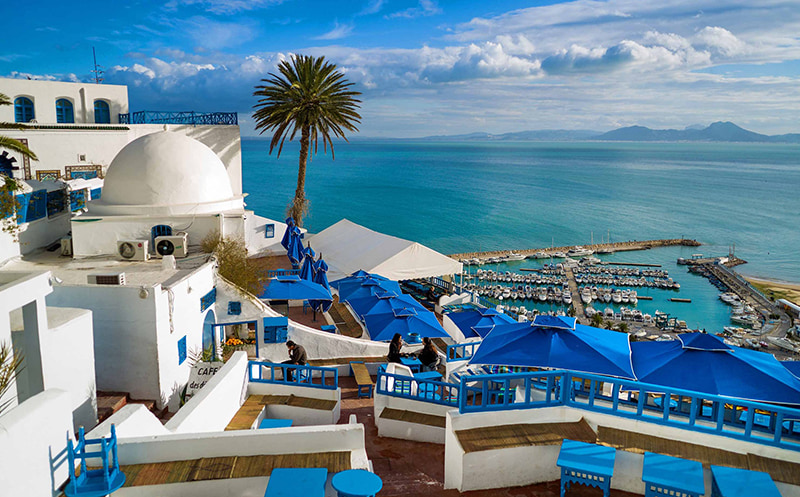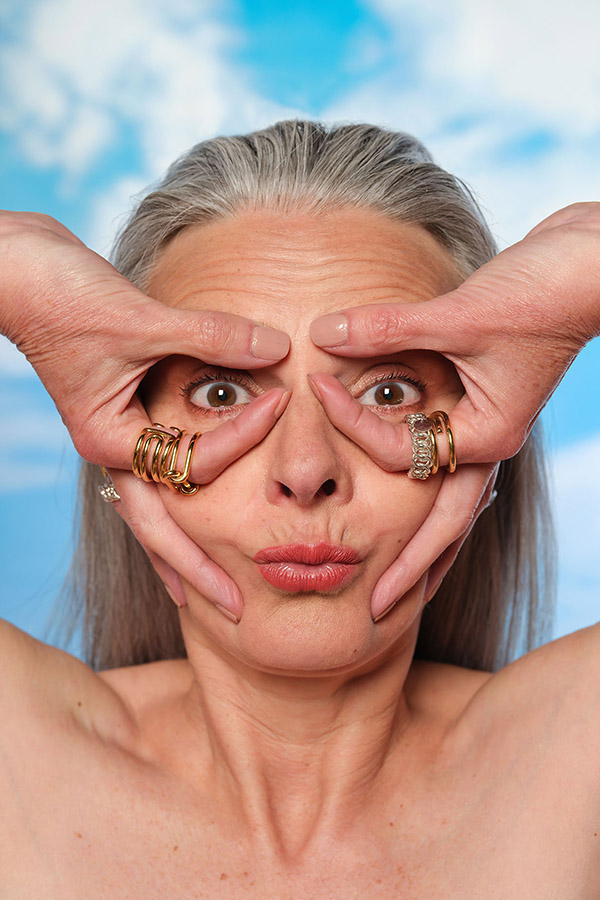
Tunisia: creativity between millennial history and libertarian enthusiasm
Close your eyes and imagine. In front of you, a blue sea as far as the eye can see. Suddenly up there, perched on a cliff, rises a village overlooking the sea. Its dazzling white houses are clad in doors in the blue colors of the Mediterranean. A sense of peace comes over you as the scent of jasmine envelops you. Think you are in Santorini?
Missed. We are in Tunisia, in the timeless charming village of Sidi Bou Saïd. Behind the doors of these white houses hide the workshops, shops and houses of many artists and designers. This is the case, for example, of the great couturier Azzedine Alaïa whose home was transformed into an art gallery after his death. Surprising? Certainly, because when you take a close look at Tunisia, you never cease to be surprised. This is why today, we have decided to take you on a journey to discover this small country where libertarian aspirations, ancestral know-how and unprecedented creativity meet.
Small country with big aspirations
Carthaginians, Romans, Arabs, Berbers, Andalusians, Ottomans … Tunisia is this country in which each people has left a mark that has endured over the centuries. This crossroads of civilizations is also distinguished by its modernity, inherited from the great reforms of its history. From the end of the 1950s, for example, Tunisian women were granted fundamental rights that were rare in Muslim countries (the right to vote, the right to divorce, the right to abortion, etc.). At the same time, education for all was made compulsory.
Decades later, the small country stands out again. Indeed, just ten years ago, the streets of Tunis vibrated in an unprecedented moment of collective union. The Tunisians then rose up against the dictatorship and for democracy. Even today, the surge of freedom of 10 years ago marks the creativity of a youth thirsty for expression. Fashion, music and art continue to flourish in this young democracy always in search of more freedom, justice and equality.
Preserving and strengthening these various historical achievements is a priority for the country. And in this context, artisans and designers are no exception. It is sometimes in the tradition, sometimes in the rupture and, sometimes in the meeting of the two, that Tunisian creativity is now inscribed.
Small countries with many skills and traditions
When one strolls through the alleys of the souk of Tunis, one cannot help but be struck by the variety of colors and materials displayed in the shop windows. Vegetable fibers, leather, copper or solid silver are available in bags, jewelry and decorations of all kinds. This high place in downtown Tunis brings together all the skills (sometimes ancestral) from the different regions of the country.
There are thus stalls covered with Berber bracelets made to measure, and sometimes by the minute. We also come across baskets (koffa), handcrafted from rush mats. Of Berber origin and centuries old, this “bag” is as practical, aesthetic and ecological! A little further on, you can admire the detail of the weaving of the Tunisian kilim and margoum. These rugs made from sheep wool or cotton, often display diamond patterns, a symbol of fertility for the Berbers. At the corner of an alley, we find ourselves dazzled by a rainbow of slippers in leather or hand-embroidered fabrics. The hardest part … is choosing!
You have to go deeper into the alleys of the medina to find the fabric souk (souk al khmach). This was founded in the 15th century by a Hafsid ruler. During his reign, the weaving industry developed based on know-how dating back to antiquity. The fabric souk then continued over the centuries, nourished by the wealth of traditional Tunisian outfits (djellabas, harem pants, burnous etc.). We thus find woven wool and silk, delicately embroidered lace or tulle adorned with silver or gold threads.
It is in this corner of the medina that Azzedine Alaïa, one of the geniuses of haute couture, took his first steps as a designer. The inimitable aesthetic of his creations has undoubtedly been inspired by the history and the many Tunisian know-how. We think, for example, of the unique sense of detail in his embroidery, which echoes his first steps in the medina. Or, the drape of her dresses that recalls the outfits worn by the ancient statues of Carthage.
Voir cette publication sur Instagram
However, Azzedine Alaïa is not the only one to have found his inspiration in the recent and ancient history of the country. Creativity continues to develop in a Tunisia where you can savor and preserve a recently regained freedom of expression.
Creativity soluble in revolution and tradition
“Free culture! One of the many graffiti that now covers the walls of the country reads. It is true that the years go by, and they never stop revealing expressive and creative Tunisians, who discover and rediscover freedom, all freedoms. And this freedom is also found on the catwalks and in the workshops of creators. No clothing censorship now stops Tunisian designers!
Some are making a name for themselves in the haute couture market, such as Ali Karoui, whose creations are worn by celebrities at the Cannes Film Festival. Others seek to break codes such as the very promising Braim Klei, who offers modern collections that are far from the traditional revisited.
But for many, the timelessness of fashion is also found in the valuation of heritage. This is the case of the talented Anissa Aïda. Confiding in the AÉ label, she declares “Highlighting traditional Tunisian crafts and techniques remains among my priorities.” To do this, she uses ancestral methods from different regions of the country such as the weaving of silk, linen and cotton. The result: refined and sophisticated collections, with lines at the crossroads between Maghreb and Japan!
You will understand, the creative spirit is booming in Tunisia. And in this context, fashion is making a comeback, at the crossroads between preservation of heritage, emancipation and modernity. So a tip: keep an eye on Tunisia.
Yosra Aribi


